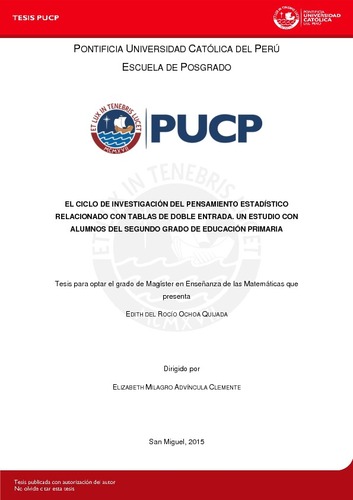| dc.contributor.advisor | Advíncula Clemente, Elizabeth Milagro | |
| dc.contributor.author | Ochoa Quijada, Edith del Rocío | es_ES |
| dc.date.accessioned | 2016-04-20T21:24:17Z | es_ES |
| dc.date.available | 2016-04-20T21:24:17Z | es_ES |
| dc.date.created | 2015 | es_ES |
| dc.date.issued | 2016-04-20 | es_ES |
| dc.identifier.uri | http://hdl.handle.net/20.500.12404/6757 | |
| dc.description.abstract | Nuestra investigación centra su atención en el análisis de una secuencia de actividades
con alumnos del segundo grado de educación primaria, basada en las cinco fases del
Ciclo de Investigación (PPDAC) del Pensamiento Estadístico propuesto por Wild y
Pfannkuch, para evidenciar si esta permite que los estudiantes transiten a través de dicho
ciclo y logran responder a preguntas del primer y segundo nivel de lectura e
interpretación de tablas de doble entrada de acuerdo a la propuesta realizada por
Curcio. Esta investigación la desarrollamos a través de un estudio de casos como
metodología de investigación, la cual nos permitió visualizar la forma en que los
estudiantes transitan de una fase a otra del ciclo de investigación del pensamiento
estadístico y logran leer e interpretar información presentada en tablas de doble entrada.
Nuestro principal resultado fue que la secuencia de actividades planteada no solo ha
permitido que los estudiantes transiten por el ciclo de investigación propuesto por Wild
y Pfannkuch, sino también respondan a interrogantes del primer nivel de lectura e
interpretación de tablas y gráficos estadísticos de Curcio, mostrando dificultades para
responder a preguntas del segundo nivel. | es_ES |
| dc.description.abstract | Research focuses on the analysis of a sequence of activities with pupils of the second
grade of primary education, based on the five stages of the cycle of research (PPDAC)
the thought statistical proposed by Wild and Pfannkuch, to reveal if it allows students to
move through this cycle and will answer questions from the first and second level of
reading and interpretation of double tables input according to the proposal made by
Curcio. We developed this research through a case study as a research methodology,
which allowed us to visualize the way that students move from one phase to another
cycle of research of statistical thinking and able to read and interpret information
presented in double tables input. Our main result was that the sequence of activities
posed not only allowed students to transit through the research cycle proposed by Wild
and Pfannkuch, but also responds to questions of the first level of reading and
interpretation of tables and graphic statistics of Curcio, showing difficulty to respond to
questions from the second level. | es_ES |
| dc.language.iso | spa | es_ES |
| dc.publisher | Pontificia Universidad Católica del Perú | es_ES |
| dc.rights | info:eu-repo/semantics/openAccess | es_ES |
| dc.rights.uri | http://creativecommons.org/licenses/by-nc-nd/2.5/pe/ | * |
| dc.subject | Matemáticas--Estudio y enseñanza (Primaria). | es_ES |
| dc.subject | Educación primaria--Investigaciones. | es_ES |
| dc.title | El ciclo de investigación del pensamiento estadístico relacionado con tablas de doble entrada : un estudio con alumnos del segundo grado de educación primaria | es_ES |
| dc.type | info:eu-repo/semantics/masterThesis | es_ES |
| thesis.degree.name | Maestro en la enseñanza de las Matemáticas | es_ES |
| thesis.degree.level | Maestría | es_ES |
| thesis.degree.grantor | Pontificia Universidad Católica del Perú. Escuela de Posgrado | es_ES |
| thesis.degree.discipline | Enseñanza de las Matemáticas | es_ES |
| renati.discipline | 199117 | es_ES |
| renati.level | https://purl.org/pe-repo/renati/level#maestro | es_ES |
| renati.type | http://purl.org/pe-repo/renati/type#tesis | es_ES |
| dc.publisher.country | PE | es_ES |
| dc.subject.ocde | https://purl.org/pe-repo/ocde/ford#5.03.01 | es_ES |






